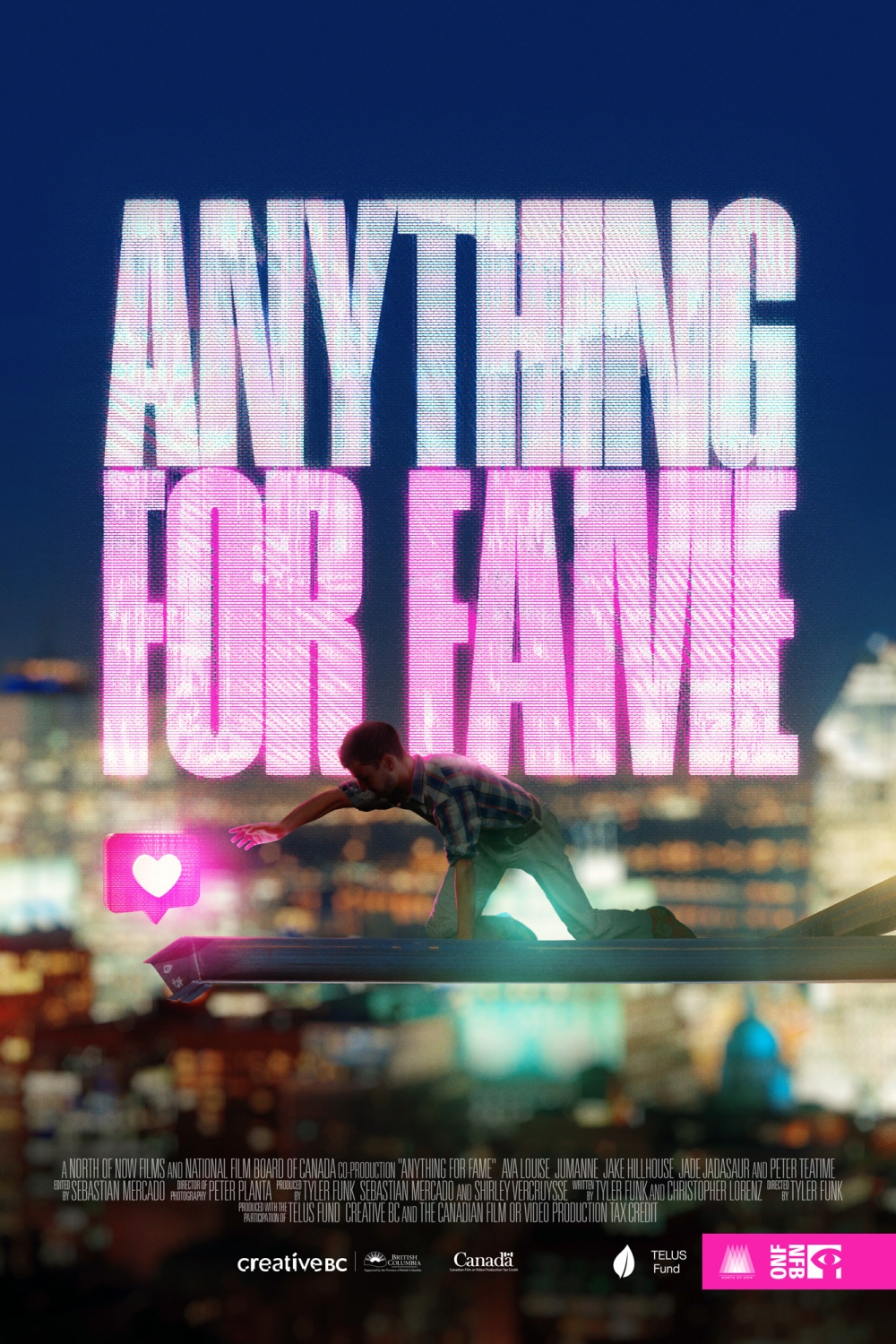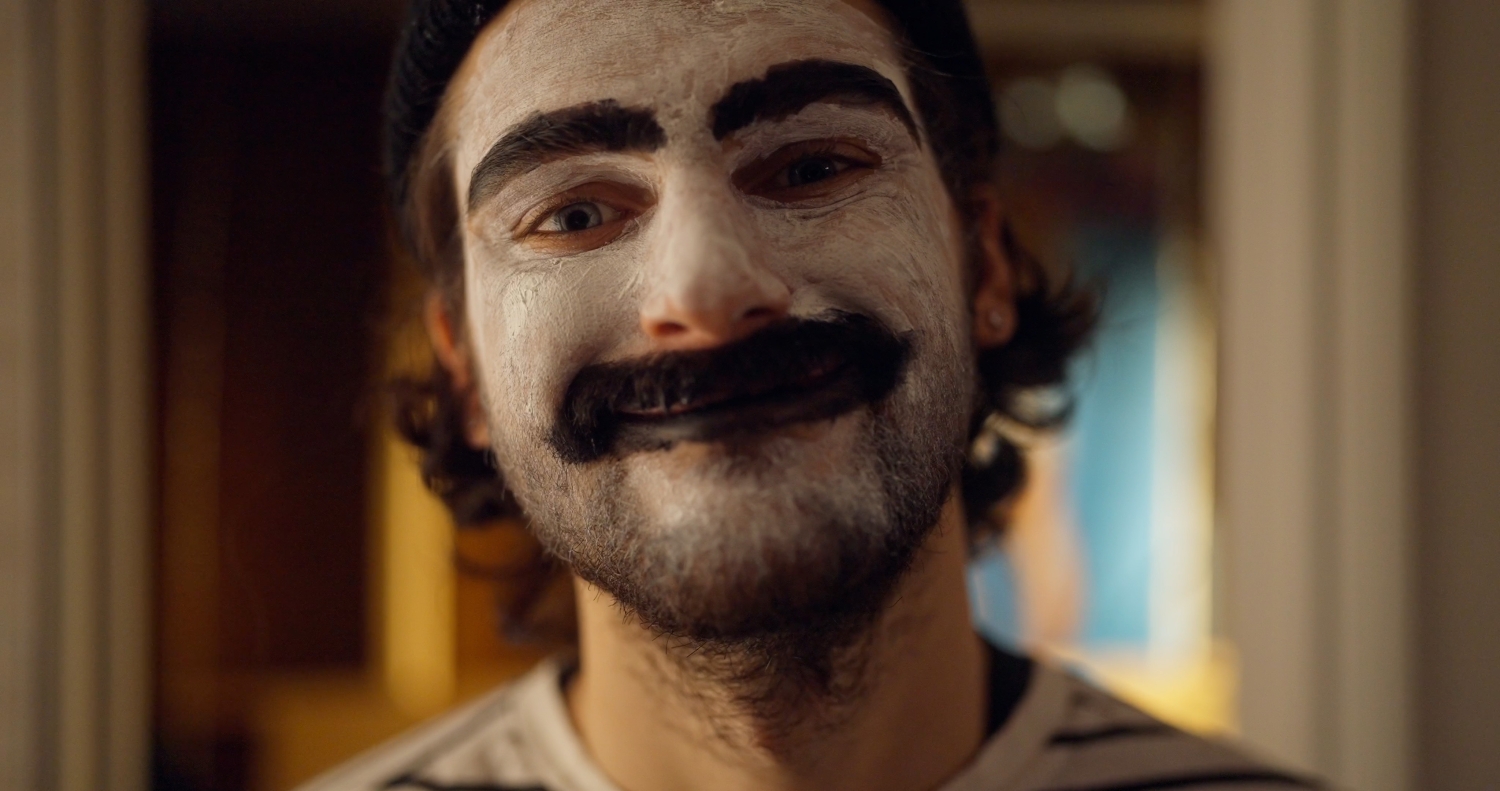In the ruthless “attention economy” of the internet, young influencers gamble everything for fame-‘n’-fortune. A startling and timely study of contemporary celebrity, Anything for Fame ventures into the virtual Wild West to profile an ambitious—and reckless—new breed of content creator. Hungry for notoriety, they venture to unprecedented highs—and lows—in pursuit of that white-hot commodity, clout.

At a time when the Internet is radically reshaping global economics and culture, Anything for Fame examines the phenomenon of online celebrity with empathy, insight and its own arresting sense of style.
Anything for Fame is now available to watch on NFB.ca. The film deals with mature subject matter. Viewer discretion is advised.

National Film Board of Canada, Anything for Fame
Read a conversation with director Tyler Funk:
What was the genesis of Anything for Fame?
There’s an important back story. I’m part of a small lifelong group of friends. We grew up together in Banff, and by Grade Four we’d already decided we wanted to be filmmakers. Later we moved to Vancouver and went to film school together. There was myself; Sebastian, the producer and editor on this project; Conor, our writer; and David, our actor.
David was always doing outrageous things. He’d jump on the Skytrain tracks, chug litres of milk until he puked—anything to get attention, to make people laugh. And then, while we were at film school, he jumped off a bridge. It really shook us up. Over a decade later, we’re all still processing what happened.
So when I first noticed all these young content creators doing outrageous things, it reminded me of David. We all crave attention and relevance, but it’s a fine line between seeking attention and crying for help. It’s easy to judge, to see content creators as extreme entertainers, to forget that they’re real people. And I started asking myself, what’s really going here? What drives them to such extreme behaviour, and to post it online? Why are they willing to risk so much for fame? And most interesting of all—what is Internet fame and how can it change your life?
How did you determine your final lineup of interview subjects?
When we began, back in 2017, we were planning a shorter film, focussing on a single content creator, a guy called Zackass. But then he signed a deal with MTV and dropped out. He’s in the latest Jackass movie, as a matter of fact, which connects in interesting ways to Jake Hillhouse and his storyline.
Later, after the NFB came on board, we decided to make a longer film, featuring multiple protagonists from different backgrounds, working in different genres. So we started looking for new subjects, scrolling for hours though different platforms: Reddit, Instagram, TikTok, YouTube. Whenever we saw someone doing something different, breaking the mould in some way, we’d reach out to them. Peter Teatime and Jake Hillhouse were on board early on. Jade and Jumanne were added later, just before principal photography.
Some influencers are big stars, with agents, and wouldn’t participate if we couldn’t pay huge fees. When we first spoke to Ava, she was interested but her agent seemed less so. It was only later, after we’d started filming, that we contacted her again, and she said ‘she was down.’ Jumanne is an interesting case. He had this big moment when he was making world news, getting calls from TMZ and other media. Anyone on Reddit knew about him and his explosive Subway videos.
We contacted over 200 influencers, but in the end, it came down to trust. The project needed a buy-in from all parties. We needed the content creators to want to work with us. They’re trying to make careers by showing one particular side of themselves, and we’re asking them to reveal something of their private lives. If the film was going to work, we needed that access.
What kind of ethical issues did you encounter?
The biggest challenge was navigating the fine line between what was right for the film and what was ethically right. We inevitably had to cancel plans to shoot with some content creators, and to cut material we’d shot with others, and that was hard because I believe everyone has a profound story to share if you take the time to listen. Unfortunately, we didn’t always have time, in the shooting schedule or in the final cut of the film itself.
Other creators had mental health issues, and it would have been a very different film if we’d included them. People pursue careers as content creators in so many ways, so we needed to know how our subjects approached social media. Were they aware of the game they were playing, that they were creating characters? Or had they gone viral due to a moment of poor judgment? Take Jumanne: he’s not vandalizing stuff because he wants to get arrested or hurt people; he’s playing a game that he’s seen other people play.
So all our subjects are aware of that. They’re playing a game that the algorithm dares them to play. But the game has its victims. Jake’s an example. He’s good at creating content that people want to see. But then he gets banned—banned by the same platforms that gain views from his content.
The platforms themselves are always changing. They’re happy to exploit young creative energy—until the brands are not happy. During their growth period, they appear to encourage any type of content, so young creators build brands by being extreme. Which works until it doesn’t. I don’t advocate for content creators doing dangerous stuff, but it’s ridiculous that TikTok can ban Jake while running ads for a Jackass movie that has literally stolen his game. Platforms need to have guidelines, and those guidelines need to be transparent, easy for creators to understand.

National Film Board of Canada, Anything for Fame
Did your perspective on the subject evolve during production?
Whenever you dive this deep into people’s lives, you feel more empathy for them. We’re interested not just in how people go viral but in what happens to them afterwards, and at a certain point we realized that parents could be part of the story. And those are now some of my favourite scenes. We get to hear from the moms, to see the content creators in a completely different light.
It’s easy to say, ‘these are just dumb kids doing crazy things’ if all you see is their online presence. But when you look at all the other pieces, it’s hard not to feel for them. Social media is not like sport, where athletes play with established rules and clear goals. The rules of social media are always changing. Vulnerable kids are pushed to do outrageous things, and then get judged in often terrible ways. The online comments can be brutal—vicious comments on their bodies, their life choices, or even how to end their lives.
So we try to view their content as just that, a product they create in an effort to make a living as entertainers. It’s easy to make moral judgments. Ava is a great example of this. Her toilet-licking video became international news, and everyone had an opinion about it, complaining about the reckless and corrupt behaviour of young creators. But why did her video get so much attention? There’s an audience for this type of content. That audience bears some responsibility too.
What kind of creative choices did you make in crafting this film?
‘Never be boring’ was our motto, and our style mirrors social media in some ways. It’s got the same kind of fast pace, the same kind of dopamine hit. The film is wall-to-wall dialogue or music. We didn’t want to give the audience much time to reflect until the end.
When filming the interviews, we mimic what you might see on YouTube, the same kind of direct address. And by featuring multiple protagonists, we’re aiming for the feel of a TikTok feed, presenting a collage of creators, different from each yet similar in some ways.
We could have told this story through one individual, but we wanted to show the bigger system at play. You’ve got this algorithm, always pushing the limits, and then you’ve got all these different creators, each approaching content from a different angle, trying to pursue careers in the Wild West of the Internet.
Any collaborators you want to mention?
My main collaborator is Sebastian Mercado. We’ve known each other ever since Grade Two and we went to film school together. We’ve worked together for about 10 years now. He edited the film and did sound, and I wrote and directed.
Our cinematographer is Peter Planta, a friend we made while at film school. The three of us spent over 70 days together, staying in questionable hotel rooms, travelling on the worst flights, doing whatever we had to do to stay within budget. We could have done a news report version of this story, shooting everything in a week or two, but we wanted to take time, to follow our subjects and their changes.
It was a weird time to be making a film—during the second wave of COVID and then the Omicron wave. We were fully vaccinated and wore masks all the time. That was kind of strange: most of our interview subjects didn’t see our faces for months.
How does Anything for Fame align with your other creative work?
Early on I decided to make a living as a content creator, so I’ve bounced around a lot, working on a range of different projects. I’ve made over 50 commercials; I’ve made web series for eight different brands; and I recently worked with Jann Arden on a project about care giving. A couple of years ago, I got to work with Paul Scheer, on an animated series for Vine called White Ninja, and that’s when I started really paying attention to influencers and their world.
I like to be always working, and that’s something I admire about all the content creators: they just go out and get it done. So I’m not too precious. I’m happy to work on all kinds of projects so long as they’re interesting and fun.
Anything for Fame is my first feature doc, and that feels like a milestone. It’s great to be working with my best friend, Sebastian, and we’ve got a slate of about five documentaries in various stages of development. They all explore web culture. It’s a subject that fascinates us!
How do you hope audiences will react?
I hope they react with empathy, both for the creators and for each other. If we want our creators to create more positive content, we as an audience have a role to play. And I hope people walk away from the film with a better understanding of the Internet, less afraid of it, and with a better understanding of how hard it is to be a content creator.
The idea that people can make careers as content creators is a relatively new phenomenon, and Internet culture as a whole is always in flux, so I hope lots of people will be interested in this story. We’re pulling the curtain back on a particular aspect of Internet culture—the whole influencer world.


